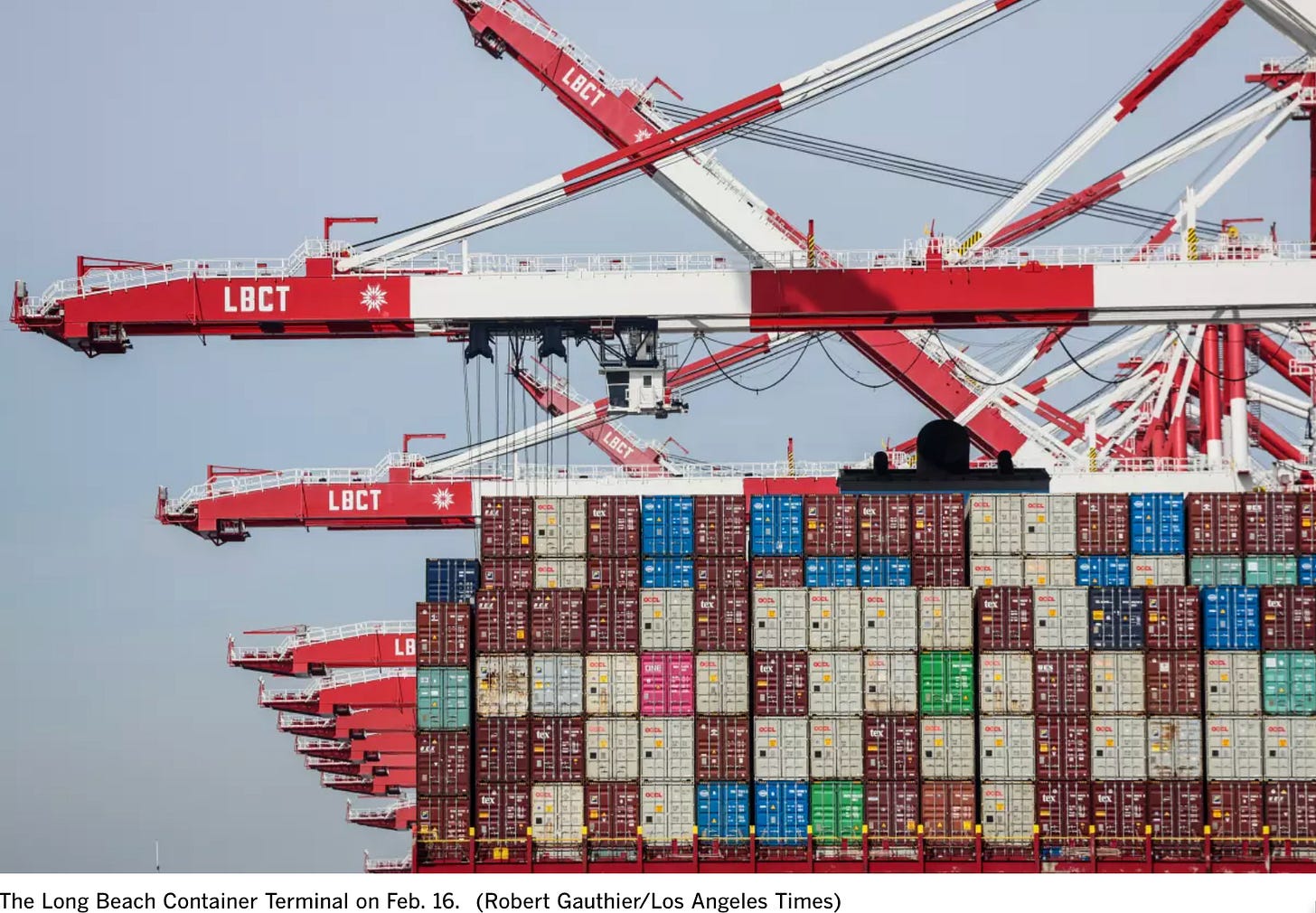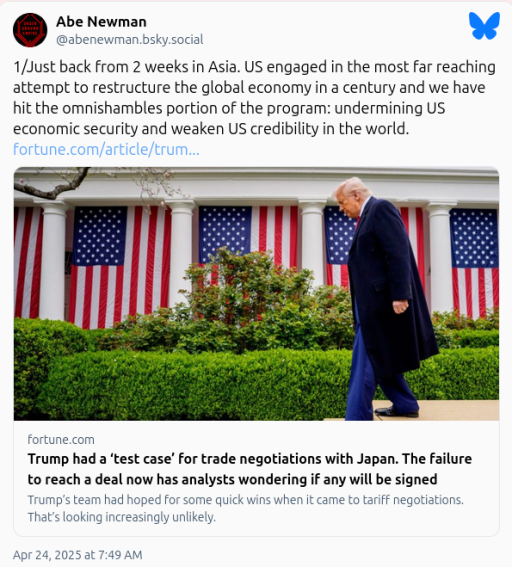8% of the Flow of US Real GDP Is Likely to Vanish in the Next Three Months: The Ports Will Be Empty, & then the Shelves


Launching a strategy-less trade war has consequences: fuck around and find out what happens when you make trade policy as a side-effect of performance art:
China loses $4 billion a week that it has to cushion and cover, and the US loses 10 times that.
You cannot retail, ship, inspire, or get paid for designing goods that do not arrive - yet the Trump administration pretends that the 86% of the economy that is not imports will be just fine this summer…

So Trump flopped (or is it flipped? changes come too fast to keep track) on cars.
Do these people think that cars are manufactured in a vacuum, separated from everything else??
The stupidity is literally hard to believe.

Gene Seroka of the Port of Los Angeles predicts a 35% drop in shipments through Long Beach , as Chinese exports to the U.S. grind to a halt. This isn’t happening as the result of a negotiation move—there are no negotiations , no plan, and no economic policy beyond some slogan “fair trade” slogans.
The Trump administration has isolated itself not only from China, but from willing trade partners like Japan, Mexico, and Korea, all of which played ball with Trump I but get nothing in return, and now find themselves not in any “green box” at all. The likely result? Stagflation. China, with its centralized coordination, is maneuvering to blunt the damage and spread out responsibility for its $4 billion a week of likely economic losses that have already started. The U.S., led by a chaos monkey, is barreling toward a breakdown in consumer access, manufacturing continuity, and economic growth—with no relief on the horizon, and no plan for cushioning the knock-on consequences of losses likely to be ten times as much, or twenty times as much once one factors in the wedge between exchange-value and true economic use-value.
This is about value chains : the intricate layering of value-added activities by which a $100 shoe contains $20 in resource and manufacturing costs and delivers an extra $80 in use value in logistics, design, and consumer resonance. If the physical good doesn’t show up, all the value built around it disappears. The Trump administration claims deregulation and tax policy will boost the 86% of the economy that are not imports, make up for this, and claims not to understand why tariffs rather than tax policy or deregulation dominate the headlines. But the numbers—and soon the empty racks—will say otherwise.
Economic bells, tolling:
Laurence Darmiento : Traffic at the Port of Los Angeles set to plunge amid tariffs < https://www.latimes.com/business/story/2025-04-24/traffic-at-the-port-of-los-angeles-set-to-plunge-amid-tariffs-disruption >: ‘Imports at the Port of Los Angeles are expected to plunge in the next two weeks, even as negotiations over the final tariffs that China and other countries must pay are still being negotiated by President Trump. That was the sobering message that port Executive Director Gene Seroka had Thursday for the Los Angeles Board of Harbor Commissioners during an update on port activity. “It’s my prediction that in two weeks’ time, arrivals will drop by 35% as essentially all shipments out of China for major retailers and manufacturers have ceased, and cargo coming out of Southeast Asia locations is much softer than normal,” Seroka told the board …
Share Brad DeLong's Grasping Reality
BUT THERE ARE NO NEGOTIATIONS BEING NEGOTIATED WITH RESPECT TO THE TRUMP TARIFFS ON CHINA. TO SAY THAT “NEGOTIATIONS OVER THE FINAL TARIFFS… ARE STILL BEING NEGOTIATED BY PRESIDENT TRUMP” IS TO FALSIFY WHAT IS GOING ON.

I mean, there are not even ongoing negotiations with Japan, which very much wants to negotiate.
And it seems as though Sheinbaum and Carney have also given up on talking to Trump, expecting a rather thorough reset to hit the Trump administration in the next couple of months.
Here is my guess as to what the most likely scenario is:
Back when my wife’s and my older kid was running high-school cross-country, we would get him Nikes to run in.
The exchange-value of the Nikes we got him was divided, roughly:
-
10 bucks for the raw materials.
-
10 bucks for the production labor
-
20 bucks for Nike for design, organization, return on capital, and market-power profits.
-
10 bucks would be for the symbolic links created between the shoes on th one hand and athletic achievement kinds of things—“just do it”, the mental part of the game that made Michael Jordan an extraordinarily rich man in his day.
-
15 bucks for transportation—1 buck from the Pearl River Delta to the Port of Oakland, and then 14 more about that to get the shoes to where we could see them and buy them and carry them home.
-
35 bucks for getting him not just a shoe but the right shoe, in the right size, fitted to him by a half-crazed marathon working at an athletic shoe store in Walnut Creek, California.
And over and above that 100 bucks in exchange value:
-
Figure another 100 bucks in use-value margin for getting him a really good shoe for the task rather than just running in converse sneakers.
So 200 bucks in total economic value created for us from the athletic-shoe trans-Pacific value chain in the globalized value-chain economy late in the decade of the 2000s. And 100 bucks recorded in the National Income and Product Accounts—$100 in final sales in the U.S., minus $20 in imports, with the balancing $20 in exports counted in GDP over in Asia.
Of this, $10 were raw materials from east and southeast Asia, and $10 were production labor costs in the Pearl River Delta.
Let me hasten to say that all of that $200 in exchange value was truly real value to us. Our willingness-to-pay for the shoes really was $200: that we could get them for $100 was a gift to us from the market system that had created not just a sneaker industry but a proper athletic-shoe industry. The raw materials and the production labor added real value to the product. The services performed by Nike—capital services, orchestrating the division of labor, design, the information-provision which is the flip side of its market power demand-slope margin—were very real. Also very real were the symbolic links: people feel more confident and their heads are in a better space because wearing the shoes ties you into the East African Plains Ape satisfaction loops of doing things in groups and emulating those of prestigious accomplishments.
Value added by transportation is very real as well. Product selection too. And the fitting by the half-crazed marathoner was something we would have handsomely tipped him for, were that appropriate.
There is a strong tendency for normal people and also for economists who know better to fell that the “real value” of the shoe ought to be its marginal production cost of $20. That is, after all, what the commodity is: a shoe. That is its thingness. And that carries with it the idea that all the rest is somehow not really there, or there but not really real.
But that is completely wrong.
Even in the year -3000, the marginal exchange-value of an ingot of bronze smelted into being at the tin mine in Afghanistan or Cornwall was essentially nothing compared to what the Boule and Demos of the Athenai would pay for that ingot when wheeled up on an ox cart from the Port of Peiraieus ot the Akropolis, which was in turn much less than the amortized use-value of that bronze incorporated into the 90-ton statue of Athene Promakhis.
Today it is more so. Today wedges between use-value and exchange-value created by our extraordinary ability to invent new uses for new types of commodities are immense. And as far as exchange-value is concerned, getting the right physical commodity to the right place at the right time attached to the right information in a condition that it can be put to its best and highest use—that is truly of much more value than the marginal production costs.
But—and here is the kicker—the physical commodity has to be at the core. No physical commodity, and all of the other service-sector components of value—the use-exchange wedge, retail, wholesale, transportation, design, organizational services, and all the rest—vanish into nothingness.
At the Semafor 2025 World Economy Summit, Stephen Miran, Chair of the President’s Council of Economic Advisors and—well, I don’t think I can call him an “economist”, can I?; he was very insistent during the conversation that his views on economic issues were not guiding the administration; so flack and an enabler, or maybe apparatchik?, yes—Trump apparatchik sat for an interview by Liz Hoffman:
Miran said, among other things, that:
-
the Trump administration is devoting a lot of resources to technology—“entire teams” inside the White House are focused on AI and crypto and other areas of innovation; the administration has an Office of Science and Technology Policy; and David Sacks is working on stuff.
-
deregulation is of paramount importance, and that economists dramatically underappreciate, and that the deregulation Trump is going to accomplish will raise the rate of the country’s economic growth in the range of 0.3 to 0.9%-points per year.
-
Trump has heen barreling full steam ahead on taxes and deregulation even as the press has been focused on tariffs.
-
Imports are only 14% of the economy, so all this tariff stuff really is affecting only a very small part of the economy, while the tax relief and deregulation are going to affect the entire 86% of the rest of the
-
He did not know why people had been disproportionately discussing tariffs rather than the tax cut and deregulation program that is more important and is steadily moving forward.
-
Americans—CEOs and workers alike—are all going to be very happy with where the economy is by later this year.
Here is what I think is likely to happen with respect to China. America imports $500 billion a year of merchandise from China. That flow—$10 billion a week, in the context of U.S. GDP of $550 billion a week—is, as of two weeks from now, effectively stopped: embargoed. China will take that $10 billion a week and have to find some other use for it. They will find somebody else somewhere in the world to buy the shoes—not for $20 to feed into the $100 final-sales exchange-value value chain, but for, maybe, $12, a 40% haircut, as they go to somebody who is not rich and not really needing those shoes because they are running seven miles four days a week.
Loss to China: $4 billion a week, which will create discontent and require redistributions to manage.
Here is what I think is likely to happen with respect to America. The $10 billion a week of merchandise imports from China is effectively stopped. And that means that the labor going into design, organization, return on capital, and information-transmission now receives not its $10 billion a week, but rather zero. The $5 billion a week for symbolic links vanishes too. So does the $7.5 billion a week for transportation. Plus the $17.5 billion a week for wholesale and retail.
Loss to the U.S.: $40 billion a week. Ten times the loss to China.
And China, with a competent government, now has plans for how to cover the loss of revenue to the production factories in the Pearl River Delta, in Greater Shanghai, and elsewhere. And China has plans for how to find and distribute the goods to alternative customers inside and outside of China.
The Trump administration has no plans. The customers are going to come in to Saks to meet with their personal shoppers, who will then say: I am sorry, but the racks are empty. And there are no factories anywhere else in the world able to step up to make what is now made in China in any period of less than two years. And who will want to invest now in that stepping up, given that U.S. “policy” is made by a chaos monkey?
The only silver lining—if you want to call it that—is that some of China’s goods production will show up in the United States. Women with needles and scissors in Vietnam will cut out “Made In China” and sew in “Made in Vietnam” labels, while people at computers with laser printers forge origin certificates, and the US Customs Service will look the other way. But at what scale will this take place, given that Trump has put a stake in the ground that the “fair” tariff rate on imports from Vietnam at 46%.
Plus there are the intermediate goods used in production locations in the United States—not just critical minerals, rare earths, and such, but little things where China has 60% of the global supply. When that stops, where are you gonna source it from? As a large chunk of intermediate inputs just disappear for a while, the loss to goods values flowing through the American economy will be bigger than $10 billion a week. How much bigger? I do not know. But I do know that the 84% is going to feel a hit from that as well.
And then there are the industries that are profitable now but that are declining. What happens if some suppliers of auto parts for gasoline vehicles go out of business when they lose their intermediate inputs from China? Who will start up a replacement business when they see the wall of the coming EV transition facing them, and the EV transition is coming.
And then there are the non-China clusterf***s on the way. Let me repost Abe Newman, freshly back from Asia:
Abe Newman :

‘ The Administration is not ready…. Japanes… keep asking what the US wants. The response... 'something big". Without a clear ask, there can be no deals. Its not just lack of information…. Even Japan… sees concessions as a road to more demands…. The administration has undermined its own position. US has threatened to snap back full tariffs in 90 days but… the snap back is not credible. And our partners know that. Moreover, partners starting to realize that there is no credible decision-making process in the US…. And… China only reinforce[s] US weakness: “This game of chicken has done nothing but enable Xi Jinping to boost his standing in and outside China, while the United States appears uninformed and unmoored.”… If negotiations are the goal… [the] Administration… tanked its strategy from the outset -- no plans, no staff, wrong escalation ladder, no commitment mechanism…. Stagflation at home and undermine[d] US credibility abroad…
Let me put this out there: when the dust settles, the NBER will date the start of the Trump Recession to May of 2025.
Whatever



From the Fortune article linked by Abe Newman:
FAFO is the basis of this administration. When you hire the right people then they already know what each lever of government does. When you elect an orangutan who hires servile sycophants they instinctively pull the levers to figure out what they do.
Between Memorial Day and July 4th, things are gonna start hitting the fan.